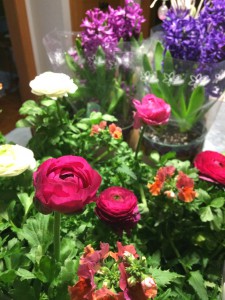Weeks ago, in mid-March I called Luurs, one of our local nurseries. I chirped cheerfully, hopefully over the phone — “Do you have any hellebores in yet?” They tried not to laugh at me as they said, “Too soon, too soon. Try back in a few weeks; we’re just ordering the first perennials now.” I hung up the phone, sad but resigned.
Then this past Sunday, I was in the city for an event, which meant an excuse to visit my favorite city nursery, Gethsemane, which is a full hour from my current home, and so too out of the way for casual trips these days. Driving up, I had made a plan, mostly about ground cover — I needed chocolate ajuga to fill in an area where I’d previously tried to do a mixed ground cover planting, only to find the ajuga crowded everything out — now I intended to just go with it, and let the thug fill in the triangular space completely. It did present a stunning sea of indigo for a month or so, and nicely choked out weeds the rest of the year. I had found the chocolate ajuga at Gethsemane years ago, so I was hopeful that they’d have that variety again.
And in general, I needed more ground cover — there were large stretches that had none, because ground cover is so tedious to plant — lots of little plugs that don’t look like much when you put them in. But so useful — if I could go back in time to the start of my garden, I’d put in ground cover across it the first season, and would have spent far less time battling weeds in the years after. So I spent the drive up in happy dreams of purple dragon lamium, dragon’s blood sedum (yes, I have a weakness for certain plant names, but in my defense, both of those are also very pretty), periwinkle, creeping thyme, creeping speedwell, sweet woodruff…
But when I arrived, I found no ground cover to be seen. Too soon, too soon! And in vain did I protest that in my own garden, the periwinkle I already had had been blooming for weeks now; this is an untimely season of warmth, and the nurseries are more conservative in their approach. Understandably, since if they sell plants that promptly freeze to death, they’ll undoubtedly have to face irate customers, many of whom won’t care that they themselves should have known the risks of planting so early.
In the end, I take away a selection of what they do have — cool season annuals, suitable for planting in window boxes and hanging baskets. It may be too early to work the ground yet, but for those of us impatient with the length of Chicago’s winters, a little consolation can be found in nemesia and ranunculus, paired with hyacinths and sweet alyssum. I ask if I can plant the hyacinths in the ground, if they’ll come back next year. The young woman gives me a pitying look — “It’s a 50/50 chance; they’re hothouse-grown, so they may not have enough strength to make it back. Sorry to give you the bad news…”
I assure her that it’s fine, and it is. I’ll plant my spring planters, to give pleasure in April, May and maybe June — when the heat gets too much for them, these little plants will be discarded for summer bloomers. And I’ll take my chances and stick a few hyacinths in the ground. Gardening is part rule-bound — a plant has its specific needs for sunlight, for water, for rich soil or dry, for warm weather temperatures, and if you break those rules, you risk complete failure.
But gardening is also about hope. Sometimes, even if it’s too soon, you just have to go for it.
(Also, the hellebores are in! Huzzah!)


I always plant my hothouse hyacinths – bought from the grocery store and Rite Aid and other non-nurturing places – and they come back. Not as full and maybe only about 2/3 -3/4 of them, but they come back. I know I live in the land where you need to spend more time whacking plants back than coaxing them to live, but I’d plant all of them.